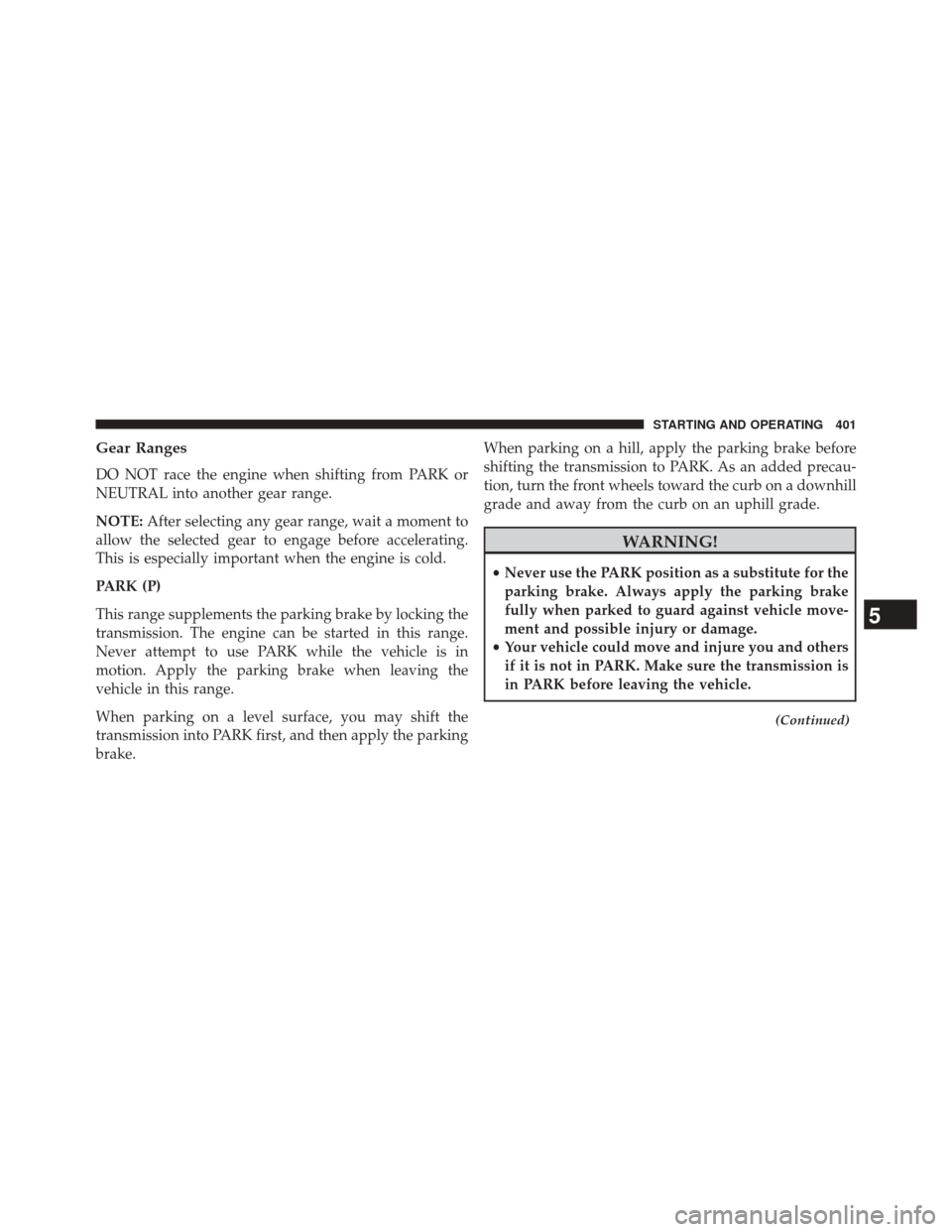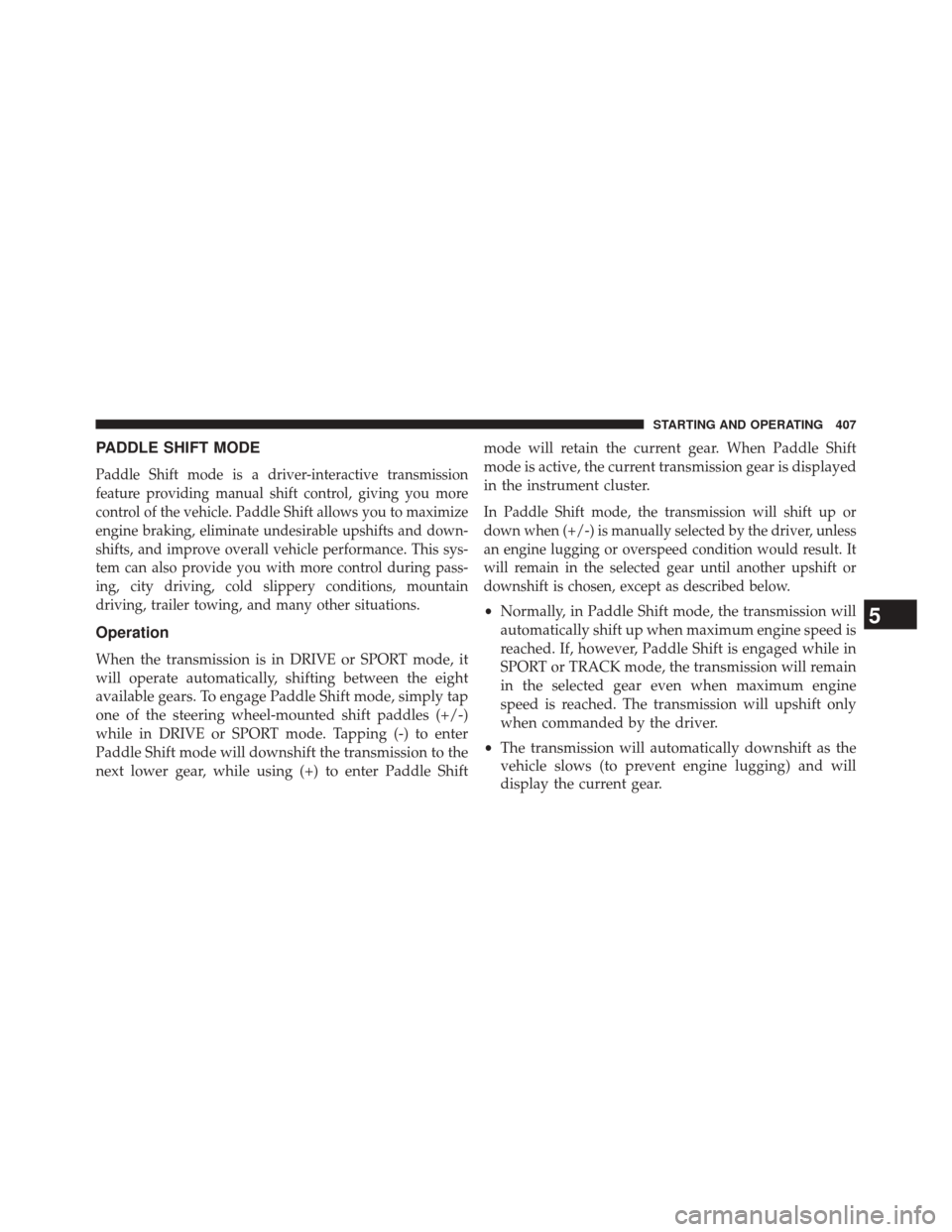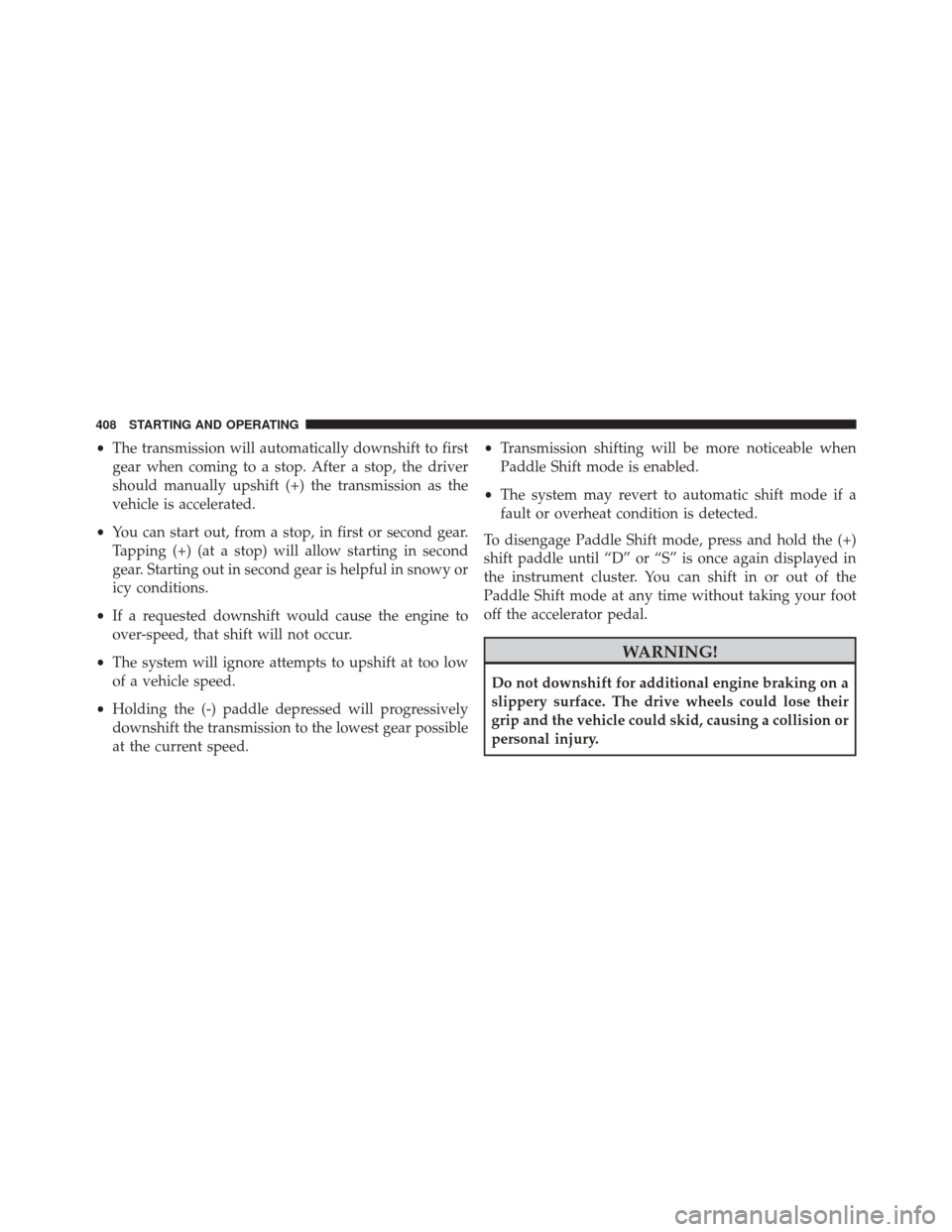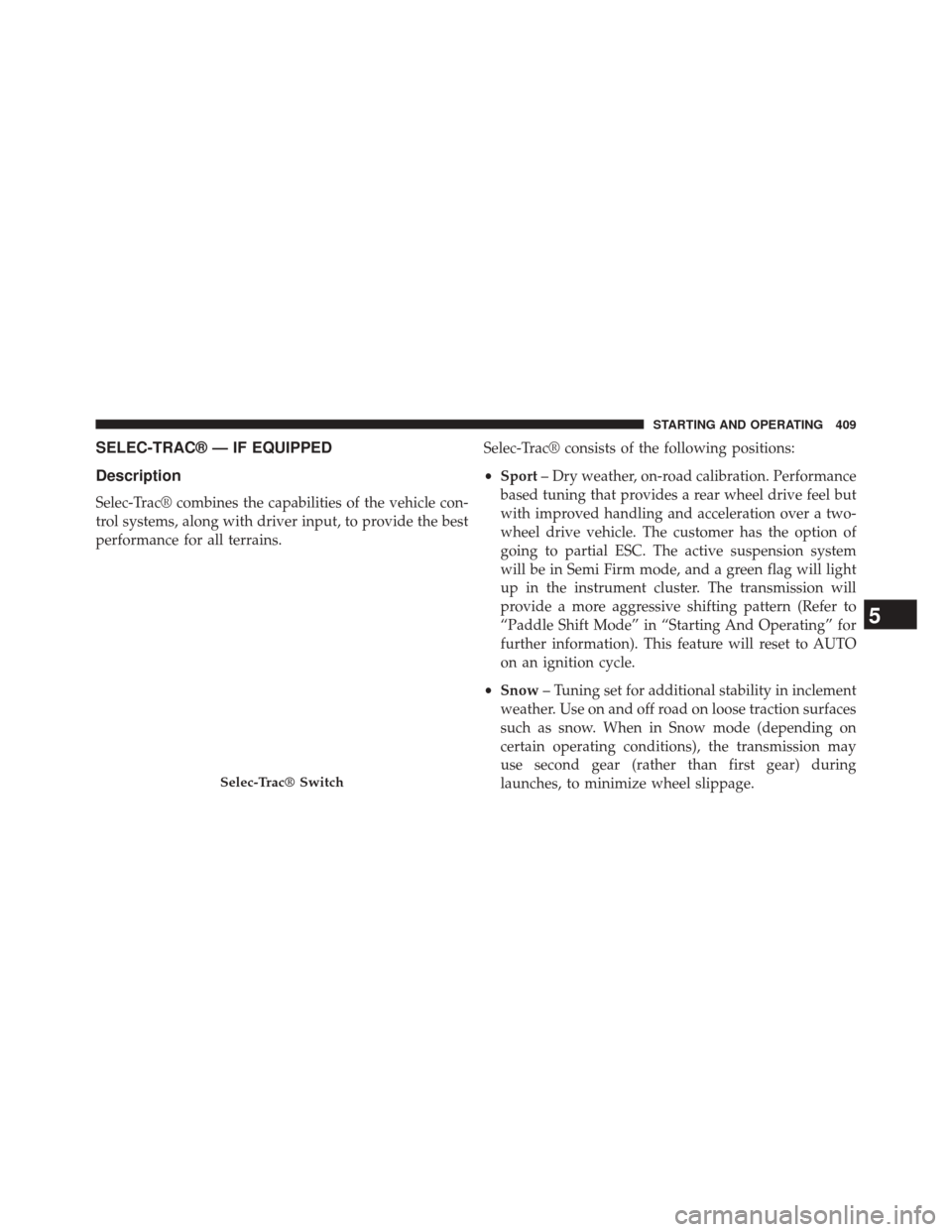Page 403 of 615

Gear Ranges
DO NOT race the engine when shifting from PARK or
NEUTRAL into another gear range.
NOTE:After selecting any gear range, wait a moment to
allow the selected gear to engage before accelerating.
This is especially important when the engine is cold.
PARK (P)
This range supplements the parking brake by locking the
transmission. The engine can be started in this range.
Never attempt to use PARK while the vehicle is in
motion. Apply the parking brake when leaving the
vehicle in this range.
When parking on a level surface, you may shift the
transmission into PARK first, and then apply the parking
brake. When parking on a hill, apply the parking brake before
shifting the transmission to PARK. As an added precau-
tion, turn the front wheels toward the curb on a downhill
grade and away from the curb on an uphill grade.
WARNING!
•
Never use the PARK position as a substitute for the
parking brake. Always apply the parking brake
fully when parked to guard against vehicle move-
ment and possible injury or damage.
• Your vehicle could move and injure you and others
if it is not in PARK. Make sure the transmission is
in PARK before leaving the vehicle.
(Continued)
5
STARTING AND OPERATING 401
Page 409 of 615

PADDLE SHIFT MODE
Paddle Shift mode is a driver-interactive transmission
feature providing manual shift control, giving you more
control of the vehicle. Paddle Shift allows you to maximize
engine braking, eliminate undesirable upshifts and down-
shifts, and improve overall vehicle performance. This sys-
tem can also provide you with more control during pass-
ing, city driving, cold slippery conditions, mountain
driving, trailer towing, and many other situations.
Operation
When the transmission is in DRIVE or SPORT mode, it
will operate automatically, shifting between the eight
available gears. To engage Paddle Shift mode, simply tap
one of the steering wheel-mounted shift paddles (+/-)
while in DRIVE or SPORT mode. Tapping (-) to enter
Paddle Shift mode will downshift the transmission to the
next lower gear, while using (+) to enter Paddle Shiftmode will retain the current gear. When Paddle Shift
mode is active, the current transmission gear is displayed
in the instrument cluster.
In Paddle Shift mode, the transmission will shift up or
down when (+/-) is manually selected by the driver, unless
an engine lugging or overspeed condition would result. It
will remain in the selected gear until another upshift or
downshift is chosen, except as described below.
•
Normally, in Paddle Shift mode, the transmission will
automatically shift up when maximum engine speed is
reached. If, however, Paddle Shift is engaged while in
SPORT or TRACK mode, the transmission will remain
in the selected gear even when maximum engine
speed is reached. The transmission will upshift only
when commanded by the driver.
• The transmission will automatically downshift as the
vehicle slows (to prevent engine lugging) and will
display the current gear.5
STARTING AND OPERATING 407
Page 410 of 615

•The transmission will automatically downshift to first
gear when coming to a stop. After a stop, the driver
should manually upshift (+) the transmission as the
vehicle is accelerated.
• You can start out, from a stop, in first or second gear.
Tapping (+) (at a stop) will allow starting in second
gear. Starting out in second gear is helpful in snowy or
icy conditions.
• If a requested downshift would cause the engine to
over-speed, that shift will not occur.
• The system will ignore attempts to upshift at too low
of a vehicle speed.
• Holding the (-) paddle depressed will progressively
downshift the transmission to the lowest gear possible
at the current speed. •
Transmission shifting will be more noticeable when
Paddle Shift mode is enabled.
• The system may revert to automatic shift mode if a
fault or overheat condition is detected.
To disengage Paddle Shift mode, press and hold the (+)
shift paddle until “D” or “S” is once again displayed in
the instrument cluster. You can shift in or out of the
Paddle Shift mode at any time without taking your foot
off the accelerator pedal.
WARNING!
Do not downshift for additional engine braking on a
slippery surface. The drive wheels could lose their
grip and the vehicle could skid, causing a collision or
personal injury.
408 STARTING AND OPERATING
Page 411 of 615

SELEC-TRAC® — IF EQUIPPED
Description
Selec-Trac® combines the capabilities of the vehicle con-
trol systems, along with driver input, to provide the best
performance for all terrains.Selec-Trac® consists of the following positions:
•
Sport – Dry weather, on-road calibration. Performance
based tuning that provides a rear wheel drive feel but
with improved handling and acceleration over a two-
wheel drive vehicle. The customer has the option of
going to partial ESC. The active suspension system
will be in Semi Firm mode, and a green flag will light
up in the instrument cluster. The transmission will
provide a more aggressive shifting pattern (Refer to
“Paddle Shift Mode” in “Starting And Operating” for
further information). This feature will reset to AUTO
on an ignition cycle.
• Snow – Tuning set for additional stability in inclement
weather. Use on and off road on loose traction surfaces
such as snow. When in Snow mode (depending on
certain operating conditions), the transmission may
use second gear (rather than first gear) during
launches, to minimize wheel slippage.
Selec-Trac® Switch
5
STARTING AND OPERATING 409
Page 412 of 615

•Auto– Fully automatic full time four-wheel drive
operation can be used on and off road. Balances traction
with seamless steering feel to provide improved han-
dling and acceleration over two-wheel drive vehicles.
The active suspension system will be in Touring Mode.
• Track –Track road calibration for use on high traction
surfaces. Driveline is maximized for traction. Some
binding may be felt on less forgiving surfaces. The
electronic brake controls are set to Partial OFF to limit
traction control management of throttle and wheel spin.
• The transmission will be in SPORT mode and pro-
vide a more aggressive shifting pattern. Refer to
“Paddle Shift Mode” in “Starting And Operating”
for further information.
• The customer has the option of going to FULL OFF
with no interaction from the ESC System. The active
suspension system will be in Full Firm mode.
• This feature will reset to AUTO on an ignition cycle. •
To w – Use this mode for towing. Vehicle suspension
will go to Firm mode. Trailer sway control is enabled
in the ESC system. The terrain switch will remain in
this position through an ignition cycle until the cus-
tomer cycles into another position.
Active Damping System
This vehicle is equipped with an electronic controlled
damping system. This system reduces body roll and pitch
in many driving situations including cornering, accelera-
tion and braking. There are 3 modes:
• Touring Mode (Available in terrain positions AUTO
and SNOW) — Used during highway speeds where a
touring suspension feel is desired.
• Firm Mode
(Available in terrain positions SPORT and
TOW) — Provides a firm suspension for better handling.
• Full Firm (Available in TRACK mode) — Provides a
full firm suspension for an aggressive track experience.
410 STARTING AND OPERATING
Page 413 of 615

Launch Mode — If Equipped
This system maximizes acceleration traction for straight
line racing. To use Launch Mode please follow the steps
below:
1. Bring vehicle to complete stop on a level track surfacewith the engine running.
2. Set the steering wheel for straight ahead driving.
3. Fully press the brake pedal.
4. Press and release the “LAUNCH” Button.
5. Press the accelerator pedal to the floor.
NOTE: If the cluster launch EVIC message indicates all
conditions are correct for launch and the throttle is
pressed to the floor quickly (within approximately
1/2 second) the system will hold the engine speed to a
preset speed (below the engine rev limiter speed). 6. Release the brake pedal.
Pressing the launch control button when launch control is
active will deactivate launch control.
NOTE:
•
Launch Mode brings the engine to optimum RPM and
waits for the driver to release the brake. Launch Mode
then uses engine throttle only to achieve controlled
wheelslip for maximum acceleration through first
gear.
• Launch Mode can be initiated in any of the Select Trac
Modes.
• Launch Mode is not available until the 500 mile
(805 km) break-in has been achieved.
5
STARTING AND OPERATING 411
Page 416 of 615

CAUTION!(Continued)
•Driving through standing water may cause damage
to your vehicle’s drivetrain components. Always
inspect your vehicle’s fluids (i.e., engine oil, trans-
mission, axle, etc.) for signs of contamination (i.e.,
fluid that is milky or foamy in appearance) after
driving through standing water. Do not continue to
operate the vehicle if any fluid appears contami-
nated, as this may result in further damage. Such
damage is not covered by the New Vehicle Limited
Warranty.
• Getting water inside your vehicle’s engine can
cause it to lock up and stall out, and cause serious
internal damage to the engine. Such damage is not
covered by the New Vehicle Limited Warranty.
POWER STEERING
The standard power steering system will give you good
vehicle response and increased ease of maneuverability
in tight spaces. The system will provide mechanical
steering capability if power assist is lost.
If for some reason the power assist is interrupted, it will
still be possible to steer your vehicle. Under these condi-
tions, you will observe a substantial increase in steering
effort, especially at very low vehicle speeds and during
parking maneuvers.
NOTE:
• Increased noise levels at the end of the steering wheel
travel are considered normal and do not indicate that
there is a problem with the power steering system.
• Upon initial start-up in cold weather, the power steer-
ing pump may make noise for a short amount of time.
414 STARTING AND OPERATING
Page 417 of 615

This is due to the cold, thick fluid in the steering
system. This noise should be considered normal, and it
does not in any way damage the steering system.
CAUTION!
Prolonged operation of the steering system at the end
of the steering wheel travel will increase the steering
fluid temperature and it should be avoided when
possible. Damage to the power steering pump may
occur.
FUEL SAVER TECHNOLOGY — IF EQUIPPED
This feature offers improved fuel economy by shutting
off four of the engine’s eight cylinders during light load
and cruise conditions. The system is automatic with no
driver inputs or additional driving skills required.NOTE:
This system may take some time to return to full
functionality after a battery disconnect.
PARKING BRAKE
Before leaving the vehicle, make sure that the parking
brake is fully applied and place the shift lever in the
PARK position.
The foot operated parking brake is located below the
lower left corner of the instrument panel. To apply the
park brake, firmly push the park brake pedal fully. To
release the parking brake, press the park brake pedal a
second time and let your foot up as you feel the brake
disengage.
5
STARTING AND OPERATING 415